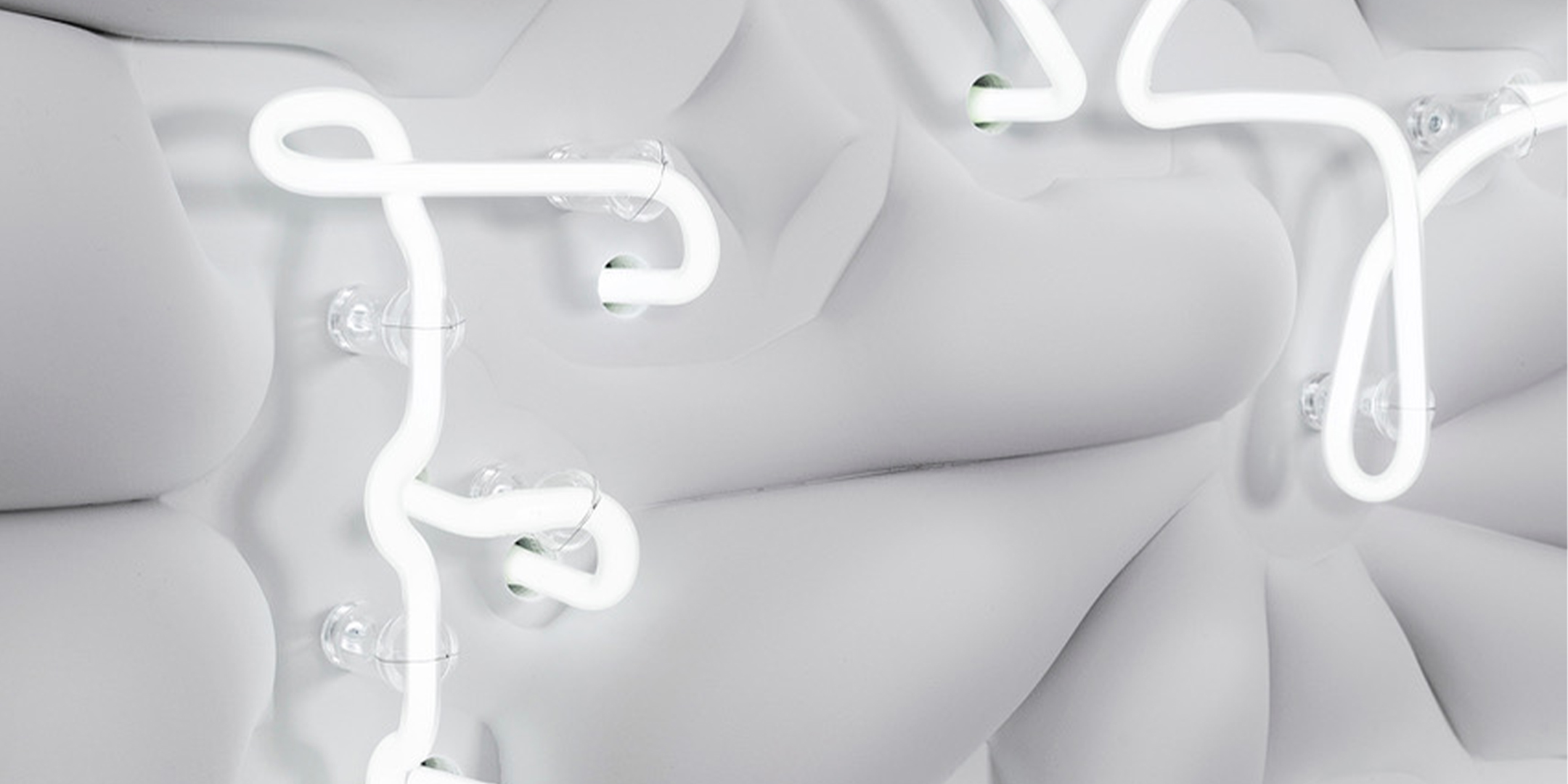Haegue Yang: The Great Forgetfulness

National Sculpture Factory (NSF) is delighted to announce the launch of the third and final annual Neon commission by artist Haegue Yang (b. 1971, Seoul).
This new commission The Great Forgetfulness will launch at 6pm on Friday 22 September, Culture Night, and will be sited in the front window of the NSF for one full year.
For several decades, the unique nature of Yang’s multi-sensorial sculptural practice has challenged our customary understanding of aesthetic perception and intellectual elaboration through her hybrid use of materials and multi-referential forms. Her ability to charge materials with new sets of significance and association affirms this commission’s commitment to investigate the material nature of neon.
The Great Forgetfulness
The poeticism that resides within Yang’s practice often belies her political concerns. Through her carefully crafted choreography of materials, Yang creates a sensorial experience while also furrowing deeper political implications for contemplation.
Yang has often used ‘light’ and ‘sight’ as a materiality. Venetian blinds, lighting fixtures, and moving apparatuses that filter light and transform space awaken our bodily senses as our perspective shifts in the ever-changing environment. The Great Forgetfulness is her first neon artwork, which in and of itself has married a sculptural methodology with the technology of neon lighting, a chemical reaction of a noble gas charged by a metal electrode creating flux, and in so doing, forming light.
For this specific Neon commission Yang conceived a sculptural relief shaped in the form of an oval disc housing flatbeds where neon letters reside surrounded by plump, cloud-like mounds. Scattered freely, the letters come to spell out ‘The Great Forgetfulness’. The matt white relief of the abstract landscape around the phrasing addresses human nature’s known propensity for forgetfulness; adding the word ‘great’ attests to how these universal traits place responsibility on humanity that certain things, figures and events should not be forgotten.
In 2009, Yang conceived a seven-part sculptural ensemble, titled Series of Vulnerable Arrangements – Concerns toward Personal Limits, expressing her diverse, complex, and therefore hard-to-summarise concerns in a self-confessional manner. One of the light sculptures is lit as a dedication to the significance of memory in the context of colonial history. Titled Great Forgetting, the piece ironically alludes to how forgetting has been ‘greatly’ generated to bury violent colonial histories, which remain to be excavated even today. Her lingering interest in the collective historical memory led her to return to this intriguing phrase for the NSF commission. Recast as The Great Forgetfulness, the work uses lighting again to illuminate the experiences and insights that humankind wishes to keep and take further, particularly after the Covid pandemic.
Yang’s practice is loaded with both intensive searches and research about the subject matter, and also considerations on the context of where her work is placed. The ‘locatedness’ of the work is informed by Yang’s own artistic underpinnings interlinked with a sense of time and place. It is presented tied to its surroundings but not bound to them.
A contemplative beacon beaming out from the front window of the former Victorian Tramway of the NSF, The Great Forgetfulness will cast its light for one whole year, inviting viewers and passers-by to ponder what one might linger on.
Haegue Yang (b. 1971, Seoul) lives and works between Berlin and Seoul. Since 2017 she has been Professor of Fine Arts at the Städelschule, Frankfurt am Main, her Alma Mater.
Spanning a vast range of media—from collage to kinetic sculpture and room-scaled installations—Yang’s work links disparate histories and traditions in a visual idiom all her own. The artist draws on a variety of craft techniques and materials, and the cultural connotations they carry: from drying racks to venetian blinds, hanji (traditional handmade Korean paper derived from the mulberry tree) to artificial straw. She is known for her multi-sensory environments that activate perception beyond the visual, creating immersive experiences that treat issues such as labour, migration and displacement from the oblique vantage of the aesthetic. Ensuring that her references remain wayward and personalised, Yang prizes fluidity over unified narratives. “Maintaining an aporia between form and content, material and subject, abstraction and history, is an act of translating the struggle of one’s life,” she has said.
A recipient of the Wolfgang Hahn Prize in 2018 and the 13th Benesse Prize at the Singapore Biennale in 2022, Yang has been the subject of major solo exhibitions at renowned museums around the world, including S.M.A.K, Ghent (2023), Pinacoteca de São Paulo (2023), the Statens Museum for Kunst, Copenhagen (2022); Tate St Ives (2020); Museum of Modern Art, New York (2019); Museum Ludwig, Cologne (2018); Centre George Pompidou, Paris (2016); Leeum Museum of Art, Seoul (2015); Haus der Kunst, Munich (2012); and the Korean Pavilion of the 53rd Venice Biennale (2009), among others in recent years.
In November, her solo show Continuous Reenactments will open at HAM, Helsinki, and her on-going stage project The Malady of Death will be presented by Performa in New York at the theatre of the Guggenheim Museum. Yang’s wide-spanning exhibition activities will continue with her participation in the Thailand Biennale 2023 and Lahore Biennale next year. Hayward Gallery in London will host a major survey exhibition of Yang’s oeuvre in October 2024. Her work has been the subject of numerous essays and monographs and is included in public collections across Europe, Asia, and the Americas.
